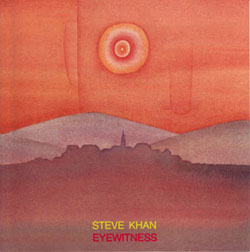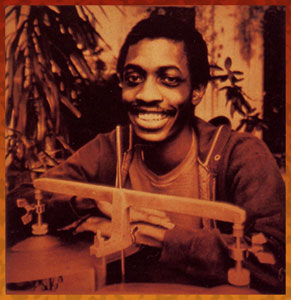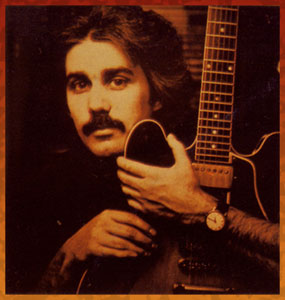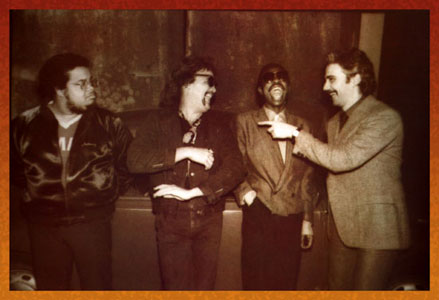On November 7th-8th, 1981,
Anthony Jackson,
Steve Jordan,
Manolo Badrena, and I walked into Mediasound Studios, then on W. 57th St. in New York City. We had put together 4 tunes, no titles, and I thought for sure that each one would run 10-minutes or more. It seemed like enough for an LP back then. When all was said and done, it turned out that only one of the tunes was of the forecasted length.

As a newly formed group, we had only had about 4-5 rehearsals or jam sessions up at Steve Jordan's loft home, but I felt so strongly about the
vibe of the music that we were creating that I went to empresario George Braun(PMC International) to see if he could possibly find us a Japanese label that might be interested in financing a recording venture. I had nothing to play for him, no cassettes, nothing - and I told him that, "I would love to record this music
before we actually figure out exactly what it is that we're doing!!!" Somehow, George had faith in me, in all of us, and he made it happen. I tried to explain to him that this was not going to be the
Steve Khan people had become used to hearing throughout the '70s, but that declaration did not seem to scare George away.
At some point during the time that we began rehearsing, someone had constructed for Steve Jordan a hi-hat set-up that housed two hi-hats within the same apparatus. Steve envisioned them being recorded in stereo. You can view the upper portion of his hi-hats in the photo that you see below. You must remember that this was long before the remote hi-hat clamp device had been created that would enable drummers to play with stereo hi-hats that would really have some separation in a mix. As these particular recording sessions are now some 34 years in the past, I can't recall all the details of exactly what happened during those two days, but, when the time came to give the hi-hats a try, Steve began laying down this wild beat, and the next thing I knew, we were composing an improvised song. As fate would have it, our dear friend, Will Lee just happened to pop into the control room as we were recording this piece, and he said to us with a big smile: "You know, you guys sound like the
Auxiliary Police!!!" And so, that is how this tune came by its title: "
Auxiliary Police"!
Back then, I was much more of a dreamer than a cynical realist, and I thought that each time we would go into the studio together, we would improvise a composition just to see what we could come-up with. I could not have foresee that we would only have been fortunate enough to have recorded 3 albums as this quartet. And so, the only other piece that we came-up with by this method was "
The Breakaway" from "
CASA LOCO." All the music that we created as a group in hindsight had two qualities that I have come to value over many others, and those are:
mood and
attitude! Often times, these very qualities triumphed over more crucial and traditional elements like: melody and structure!

Looking back, I'm amazed that we would even put these kinds of pieces out on a recording, but, in balance, there is just something so very different about the way that tunes like these two come across. And, all these years later, the great French Jazz journalist,
Frédèric Goaty, under the very clever
nom de plume of
Peter Cato, wrote a fantastic piece about
Eyewitness for
Muziq Magazine that celebrates the 3 albums by our group, and the perceived musical relationship to the great, great band, The Police. If people heard things that way, in the end, it was a most flattering honor for us, because it was not intentional on our part.
In my case, I was forced to learn just what kind of a piece of music we had created that day in the studio, because one has to write out a lead sheet to protect ourselves for copyright purposes. As I tried to put one together for this tune, it was really hard to do, because I had to define what was a melody and what was a section - that there was, in fact, some sense of structure going on - even if it was totally intuitive. For this newly constructed lead sheet, I have tried to make better sense of it all and, in doing so, maybe I even understand just what we were doing a little better? As I recently wrote in the analysis of "The Breakaway," I have often thought that the test of any musical composition would be if musicians on instruments other than the guitar might ever consider performing or recording that same piece. If a tune does not stand-up to that basic form of inspection, then it is probably not much of a composition. That doesn't mean that it can't be considered as successful on some level, even if there is not much there. For better or worse, I think that "Auxiliary Police" falls neatly into this area.
It is a strange process when someone, in this case, Steve Jordan, begins playing a beat, and just before the guitar enters, Anthony Jackson begins to prowl the lower recesses of his trusty old Fender 4-string. It would be impossible to say that I heard a key signature or a tonal center based upon what Steve was playing, but somehow, my ears and hands took me to a place on the guitar that sounded to me like I was hearing something in Db major. I suppose if Anthony had chosen to hear things with Bb as a center, making it Bbm7, or perhaps Eb as center, making it an area of Eb7(9sus) as a center, I would never have flinched at those choices. But, in all honesty, I think that I was expecting to hear lots of Db's and Ab's. I had not been playing in a harmonically free context like this with Anthony long enough to have had any conception of what he might do, or better than that, what was even possible. From this harmonic high-wire act, I learned to just go with what was happening, and make music with it, even if it was not what I had imagined.
Though I probably considered the figure that I played, at what I have now labeled as [
I2], to be something bearing some degree of melodic content, because of what Anthony played, it is not possible for me to label this entire section as a letter [
A]. If you look at the area of Db major [Db, Eb, F, Gb, Ab, Bb, C], you might expect to hear some of those scale degrees, but what is the first note that you hear Anthony dial-in via his volume pedal, and the signature sounds of his pick and flanger technique?
E-natural!!! No, I don't thing that I would be hearing that as an Fb, and calling it a 'blue note' in this harmonic context. In the end, because what Anthony played still stands as so fascinating to me, I decided to just transcribe all of it so that I could, in the end, come to a conclusion as to just how this improvisation ended-up functioning as actual music. With his own brilliant sense of form, it's remarkable that the first exposition is exactly 16-bars in length. And finally, after a wild harmonic journey, in bar 17, Anthony plays a 'C' down to an Ab, and to these ears, you could consider the next 20 bars as some kind of an Ab pedal. You don't even hear a Db, the root in my mind, until bar 33.

It's impossible to separate what Anthony was doing from what the equally brilliant Manolo Badrena was playing. His musical imagination takes one to places that touch upon Latin music, World music, and there are even sounds that might make one think that you were walking through some kind of a scary cave in a Steven Spielberg film. At our best as a foursome, that was an area that our music could inhabit, and I remain very, very proud that we could do this.
For me, letter [
B] is really the first time that anything remotely melodic appears in this piece. It's hard to believe that a letter [
B] could appear before there really was a letter [
A], but that's what things now sound like to me. So, in this section, again, I was still expecting to hear more of a sense of Db major, so it was and is so strange to hear so many Gb's being played! At least Anthony does give us one big, fat, round Db on the downbeat of bar 3. I should have been grateful for that. When an [
A] section finally does appear, for a brief moment, Anthony plays Ab to Db, but then, just as suddenly, all these D-naturals begin to appear. Thank goodness, in bar 7, there is another moment of Ab to Db before Anthony goes off exploring during the 2nd 8 bars. What is so beautiful about the group texture is that Manolo uses a great sense of space, and barely plays anything during this section except for an amazingly comical whistle during bar 8. It reminds me of all the times that Manolo would jokingly refer to himself as the
Spike Jones of Latin music!!!
What you will see of letter [
C] will not conform exactly to what you hear us playing on the recording. The lead sheet represents a
soli that I wrote out for Anthony and me to perform live, based upon what I had improvised in the studio that day. I felt that the rest of the piece was so vague, melodically speaking, that to have at least one section where we might sound like we were actually playing a composition could only benefit us when playing in front of live audiences. That part of this adventure began at the Pit Inn in the Rappongi district of Tokyo, Japan. When [
A2] arrives, Anthony is still giving me more of a sense of Gb, though there is a nice resolution to Db in bar 4.
When [
B2] arrives for a restatement, the section does begin with a Db on beat 1 of bar 1, but from there, Anthony still places a great deal of emphasis on Gb's. At the midway point in bar 6, he forcefully plays a most unexpected and brilliant low E-natural, and then constructs a wild turnaround line that leads us to a 2nd 8 bars where there is a bit more of a sense of Ab. If there can be a greater example of the uncanny telepathy that existed between Anthony and Steve Jordan, listen to the simple improvised cadence figure in bar 15 of the section ending on the and-of-2 with a break. Of course, what is Anthony's note choice on the break before hitting the solo section next? No, it's not a Db!!! It is a Gb again!!!
As the solo section, letter [
D], begins, Anthony finally centers a section around a pitch that I was always hearing in that way, and the first 4 bars, which I transcribed for this presentation, offer enough Db's and Ab's to have given us a good place to start. But then, on beat 1 of bar 4 of this section, in keeping with the harmonically zany quality of the piece, the first note that Anthony played was a D-natural, before briefly touching upon an Ab. Bars 7-8, show A.J. to be more in the key area of D major. From there, A.J. journeys all over the place, and because of the conversational aspect to all this music, it inspired me to veer away from playing consistently too down the middle. In 1991, Warner Bros. Publications offered to do a book with me, and I thought that it would be great to do an
Eyewitness Songbook. It was my goal and hope, at that time, that all the original music that we recorded would be included in the book.

It should be noted that the actual book, which has been out-of-print for quite some time, was never given that title!
I tried my best to improve the lead sheets that already existed, and attempted to fill in some of the blank spots that existed in the bass parts. I remember trying to figure out just what to do with "Auxiliary Police," and when I finally got together with Anthony to consult with him about this tune, and others, I just could not get him to explain to me how he conceived of what he ended-up playing. So, I might have transcribed 8 bars or so of what he had played, and I asked him, "So then what happens? What are you doing after that?" And he said this to me: "Oh, just write
continue à la Jamerson because that's what I'm doing!" Of course, he was referring to his great hero, James Jamerson. But acknowledging that, I don't believe that James Jamerson would have ever played some of those notes. In the end, when the book went to print, neither "Auxiliary Police" or "The Breakaway" were included! Perhaps, looking back, that was for the best, because all the lead sheets presented @ KORNER 2 have been improved upon greatly!!! In many ways, reflecting on what happened, and where we all were during those days in November of 1981, on this piece, there is no question that Anthony was leading the conversation, and it has to be noted that Manolo Badrena was the other key
texturalist, painting sonic pictures all along the way.
As we eventually emerged from the solo section, the improvised sense of form and structure took on some interesting turns, and I only realized this when trying to write out the new lead sheet. We reprise [
A], but this time for only 8 bars. It is followed by [
C2] and then, one last statement of [
B2], before we finally fade out on what I have now labeled as [
A3], because after about 16 bars of [
A2], Steve and Manolo go into a fantastic double-time feel that features Manolo's percussive cáscara on the timbal, and one final primal yell before the actual fade begins. In [
A3], I have combined elements of both [
A] and [
B], by using a fragment of [
B] in bar 4 as we repeat this section over Anthony's wandering improvisations!!! I think that this improvised fade captures something about the
spirit that pervaded all of our music, and it is that same spirit that I miss the most to this day.
When KHAN'S KORNER 2 was added as a menu item to the site, I never thought that either "Auxiliary Police" or "The Breakaway" would be presented. There just did not seem to be enough melodic material in either piece to necessitate writing out new lead sheets, beyond the ones that had been created for copyright purposes. As time has passed, and almost all of my recorded compositions have been posted, it just seemed as though I should complete the task, and have these two tunes up there as well. As has happened many, many times before, doing this work serves to remind me of the brilliant performances of my bandmantes like: Anthony Jackson, Steve Jordan, and Manolo Badrena. For that alone, it is of great value that these tunes are now part of the index.
As I wrote in a prior analysis, just what kind of music is this?!?!?! Well, it's certainly NOT
Jazz!!! But, the spirit of improvisation, invention, interaction, conversation and energy are all there. Does music need to have a category or a genre label? To musicians, absolutely not - it's just music. But, to those who bring the music to the people, those genre labels or categories are essential. They are the marketing people. And, for better or worse, we, the musicians, need them. However, with the disappearance of the record store, the CD stores, where there had to be 'sections' so that the shopper/music fan could locate his or her favorite recordings, dividing the space into genres and categories made perfect sense. It also makes sense for those who program radio stations. Does someone's music fit into their format? Honestly, I have NO IDEA just what kind of music "Auxiliary Police" might be! It certainly has plenty of attitude, a kind that is really different for non-singing music. If the opportunity ever presented itself again, I wouldn't hesitate from trying such an experiment, because the fun is in not knowing what is going to happen. It is like walking over a gorge without a safety net, and I think that we all liked that sense of risk too!!! Thanks to everyone who enjoyed this ride with the four of us between 1981-1985, it was our pleasure to have you along!!!

